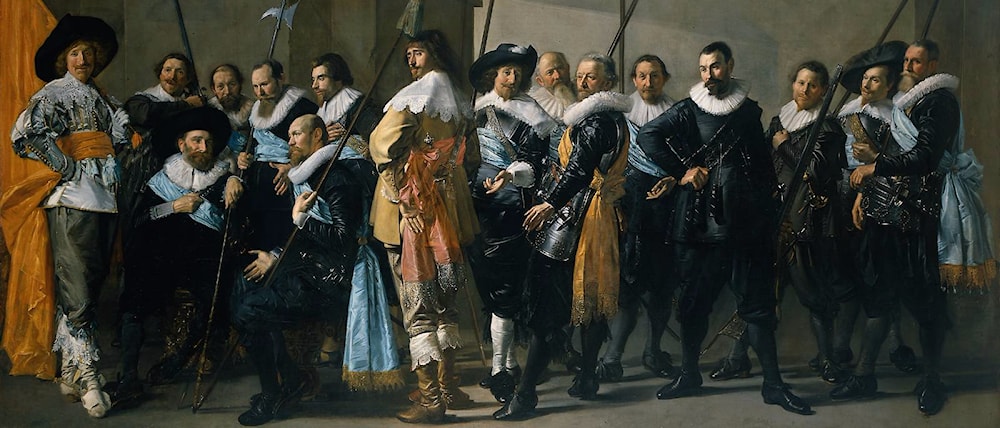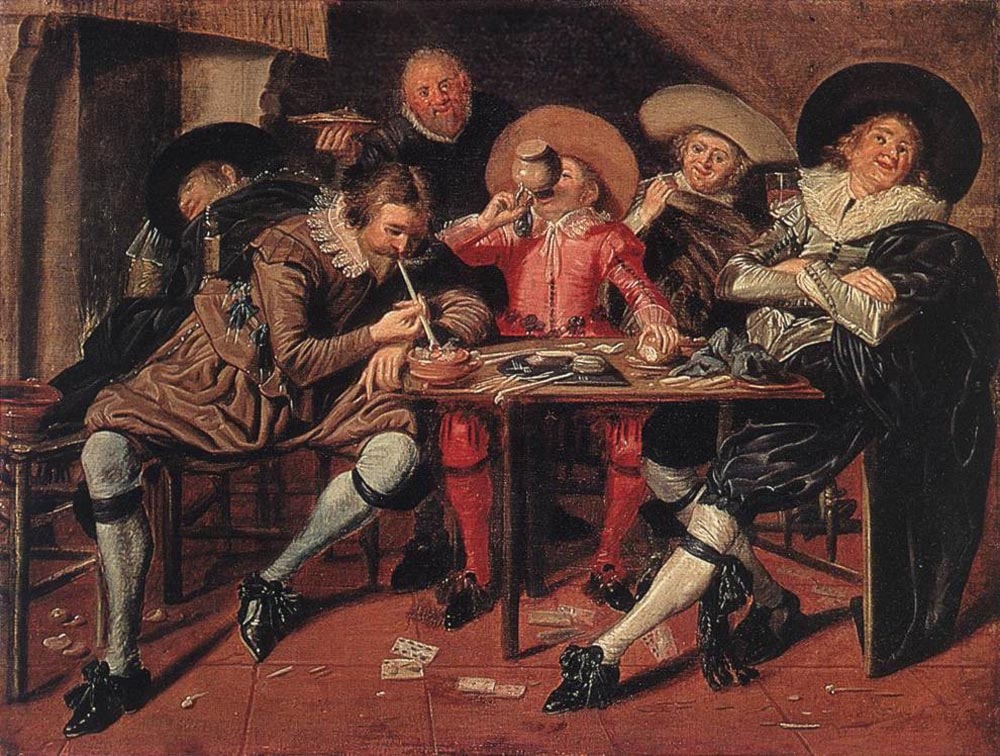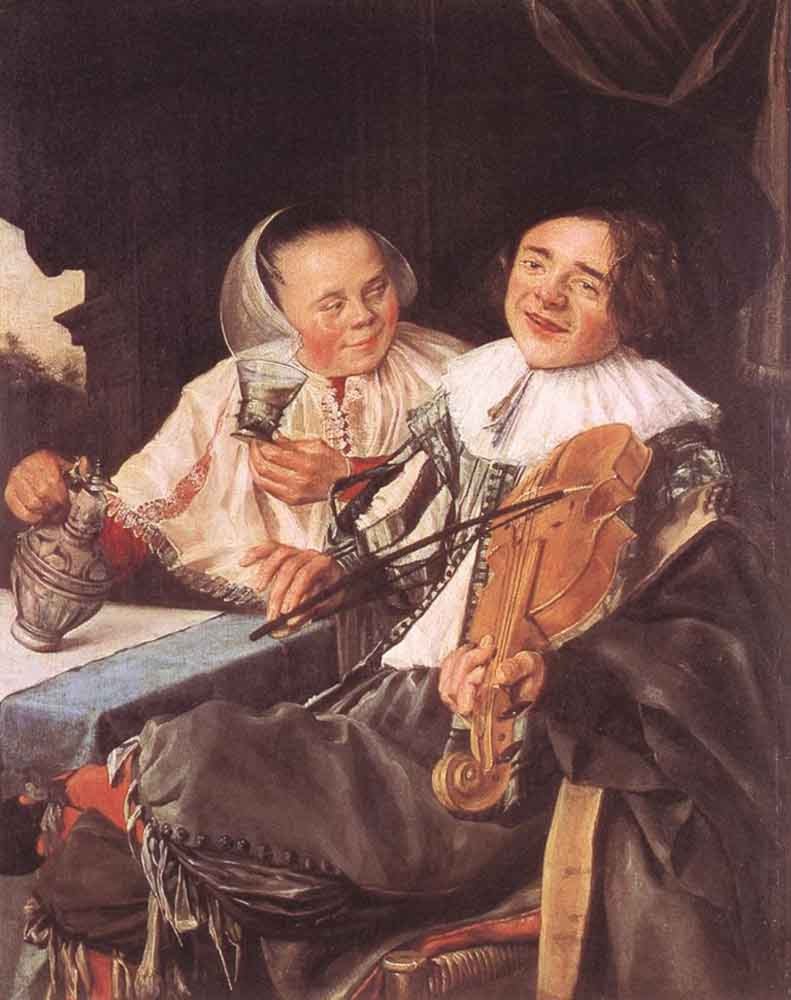Frans Hals

Frans Hals (1580-1666) was one of Seventeenth Century Holland's most prominent portrait artists, ranking second only to his younger contemporary, Rembrandt . Hals was born in Antwerp, but lived most of his life in Haarlem, where the Old Men's Almshouse in which he spent his last years in destitution is now the Frans Hals Museum. It is a short train ride from Amsterdam, and well worth the trip. He is Haarlem's most celebrated son, more highly honored now than in his own time.
The style for which Hals is known today, the painterly approach wherein the brushwork reads as a sort of calligraphy in certain passages, giving the impression that the paintings were executed quickly and directly with great confidence, actually represents a minor percentage of his overall output. What is often overlooked is that he was equally adept at more refined painting, as can be seen in many of his commissioned portraits from throughout his long career. The sketchier approach may have been employed in his more casual works as recreation, painting his drinking companions and perhaps bartering the resulting pictures to cover his lesser debts, as separate from his professional endeavors in painting portraits of wealthier clients from the upper echelons of Dutch society, in which pictures he worked to a higher degree of finish. This higher finish was expected of all professional portrait artists of his time, and their success depended upon mastery of it. He was quite successful in his career, but with a large family of ten children to support, and perhaps imprudent spending, Hals found himself in deep financial trouble later in his life, and went bankrupt in 1652. The inventory of his possessions seized in bankruptcy consisted of three mattresses and bolsters, a table, an armoire, and five pictures. This was everything he owned, beyond his painting equipment, which he was allowed to keep in order to earn his living. His fortunes continued to decline, and he was subsequently reduced to accepting welfare from the state, despite the fact that he continued to paint presumably lucrative commissions until the end of his long life. The proceeds of these commissions probably went to his creditors. Prior to his bankruptcy, he had had to give his baker some pictures painted by his teacher, Karel van Mander , to settle his bread bill.
The depressing nature of his financial problems does not seem to have affected his work, however, as his most well-known paintings exhibit a light-hearted cheerfulness, sense of humor and love of life we cannot help but be cheered by ourselves upon viewing. This is Hals' special charm. Paintings like The Jolly Toper (also known as The Merry Drinker, The Laughing Cavalier, The Jester, and The Bohemian Girl (also known as The Gypsy Girl) suggest a carefree attitude and humanity immediately likeable, as well as perhaps a clue to a cause of his money troubles. This earthy, human quality seems to have been successfully transferred to his most well known student, Judith Leyster , many of whose works are stylistically nearly indistinguishable from those of her Master. She, too, painted a version of The Jester, perhaps a copy of Hals' painting of the same subject, and her painting, The Rommelpot Player in the Chicago Art Institute, shares the delightful light-hearted spirit and charm of commonfolk subjects so characteristic of Hals. In this he tends toward the opposite end of the emotional spectrum from Rembrandt, who delved more deeply into the more serious, philosophical and introspective side of human nature. Rembrandt did, however, paint some more playful self-portraits in his younger years, and it is not unreasonable to suspect some influence in these works from the older Hals, who was already well established when Rembrandt arrived on the scene. Rembrandt was probably also influenced by Hals' approach to group portraits, in which he indicated action taking place and interaction between the various personalities involved, rather than merely having the subjects stiffly posed in a more formal composition, as had been the norm prior to Hals. Rembrandt could not have failed to notice how much more interesting the results were when done Hals' way. He (Rembrandt) then carried it a step further in The Anatomy Lesson of Dr. Nicolaes Tulp and, later, in The Militia Company of Capt. Franz Banning Cocq (better known as The Night Watch). It has also been speculated that the change from Rembrandt's early style to his later, more painterly manner was due, at least in part, to the influence of Frans Hals' pictures done in his own painterly style. It is possible, too, as has been suggested by some, that Hals may have been in turn influenced in one way or another by Rembrandt, whose pictures he must have seen in nearby Amsterdam. However, this would not have affected more than a few pictures, and there is no obvious connection apparent. Hals had his own strong individuality and preferences, which remained the dominant force in his work regardless of what might have influenced him in the works of other artists.
The earthiness of Hals' favorite subjects is reminiscent of another artist from Antwerp approximately contemporary with him; Jacob Jordaens . We might speculate here as to whether one influenced the other in that particular aspect of their respective styles as well. Frans Hals' younger brother, Dirck Hals , was also a painter, and there is some similarity in his celebration of life to the elder Hals to be seen in his work, though he is less known in our time than in his, and was not quite as sure in his draftsmanship as his older brother. It is likely that Frans Hals painted a good many more paintings in his more painterly manner than survive today. The style was not widely appreciated as finished work in its own right until much later, and paintings done in that style were regarded as simply sketches of little consequence, some of which may well have been discarded or destroyed as not being important enough to preserve. It was common practice for artists of his time and earlier to execute quick sketches in this manner as a sort of note-taking, in preparation for the execution of larger, more highly refined works, for which the sketches simply served as reference material. Often they were disposed of afterwards, their usefulness having been served once the large painting was completed. This practice continued well into the Nineteenth Century, at which time the sketchy quality became valued for its own aesthetic appeal in certain quarters, and evolved into several movements based on it, including Impressionism.
Hals is most noted in our time as the first of the painterly painters, whose brushstrokes, by themselves, serve to identify the paintings as his work so surely as to render a signature superfluous. As such, he may be seen as the innovator of the style subsequently expanded upon to good effect by such painters as John Singer Sargent , Cecilia Beaux , Anders Zorn , Joachin Sorolla and many others. However, his greater value as an artist lies in the obvious affection he held for humanity, even in its most common forms, and most specifically in the way he was able to convey that affection in his depictions of subjects from the lower classes of Dutch society. Prior to Hals, portraiture was geared toward emphasizing the more noble, respectable aspects of the subjects. Frans Hals showed us their more down-to-Earth, human side, in such a way that we cannot help but see them as being as worthy of our own love, understanding and forgiveness as they are of his. It is this element of empathy and compassion, more than flashy brushwork or anything else, that makes his work so special, and gives it its enduring appeal.
Copyright Virgil Elliott 2001, All Rights Reserved









